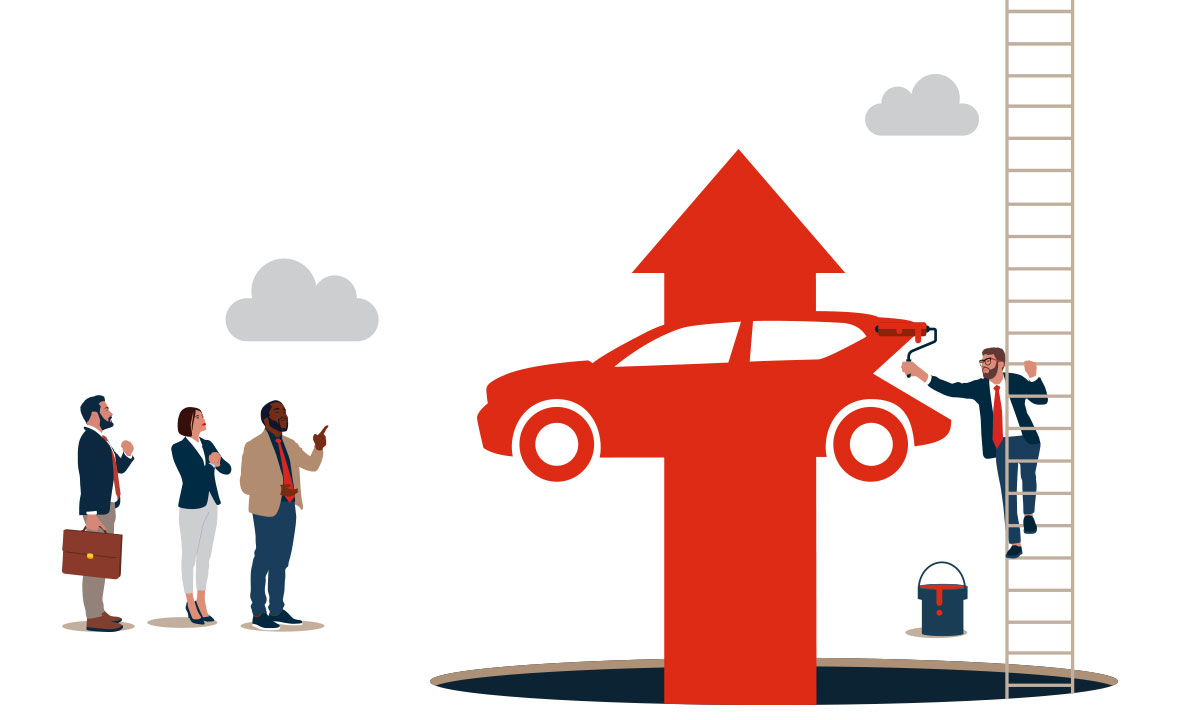
Auto industry analysts point to positive outlook for new car sales
If 2024 is anything like 2003, new car sales in Canada will continue the robust recovery from the combination of COVID, supply chain shortages, rising interest rates, inflation and the threat of a recession, according to automotive industry analysts that talked with Canadian auto dealer.
New car sales have been on the rise with year-over-year increases in the past 14 months, much to the delight of OEMs and dealers.
DesRosiers Automotive Consultants (DAC) reported new car sales in 2023 reached 1.63 million, a rise of 11.8 per cent from almost 1.5 million in 2022 when seven consecutive interest hikes and a supply shortage caused a dip from 1.63 million in 2021.
Various industry sources are projecting 1.71 million sales in 2024 and 1.78 million in 2025.
DAC reported that almost all OEMs reported sales increases from 2022. GM led the industry in total sales in 2023 with 263,084, an increase of 15.4 per cent from the year before. Mitsubishi had the largest increase of all manufacturers with 61.6 per cent.
Fanjoy says there is still pent-up demand from consumers who weren’t able to get a specific model they wanted due to production shortages, but now have that choice because inventories are building up again from the extremely low levels that hindered sales.
Volkswagen had a strong Q4, including doubling its sales in December, to finish the year up 35.8 per cent from 2022. Both Volvo Car Canada and Kia Canada reported record sales.
Robert Karwel, JD Power Senior Manager Automotive Practice Canada, told Canadian auto dealer sales collectively rose in 2023 from 2022 for several reasons, notably consumer fundamentals remained strong.
“My general feeling is that people still want to buy a car,” says Karwel. “A car is a desire-driven purchase. People wanted it and absorbed the increase in monthly payments. If you look at the proportion of down payment Canadians are putting on a car, people are putting more money down.”
He also says increased supply propelled sales.
“We were still filling in that demand from the people ordering and waiting,” he says. “But it’s not even clear cut across the industry. We call this concept competitive asymmetry. Different vehicle segments in the industry are going to be acting and behaving differently than others.”
Scotiabank Economic Analyst John Fanjoy says as vehicle production normalizes, supply-side pressures should ease the large supply imbalance from the past couple of years, which in part fueled the rise in vehicle prices.
“That may lead to lower prices but given all the shocks we’ve seen through commodity prices or manufacturing through labour costs, vehicle prices may not come down to what consumers had previously seen (from 2010-2019),” he says.
Karwel says 43 per cent of Canadians traded in their existing vehicle last year when buying their next new car, and that there was a 10 per cent year-over-year growth in total average trade-in equity, even with consumers that had outstanding loans.
Fanjoy says there is still pent-up demand from consumers who weren’t able to get a specific model they wanted due to production shortages, but now have that choice because inventories are building up again from the extremely low levels that hindered sales. Moreover, he says, during the production and inventory shortages consumers had to hold on to their vehicles longer.
“There are some people that will be looking to buy a new vehicle rather than a used vehicle and maybe they’ve saved up over the past couple of years where production was really low, but they are faced with higher vehicle prices and an elevated interest-rate environment,” says
Fanjoy. “That’s weighing on consumer demand, but you still have consumers who have been holding on to their vehicles that they eventually will need to replace.”
Karwel says his company measures retail velocity — the number of days it takes to turn one of those vehicles at retail — and that compact sport utility vehicle segment is strongest among Canadian consumers.
“The retail velocity on compact SUVs in
Canada right now is telling us we still can’t get enough of them into our marketplace, so that segment in total turns about in 23-24 days for
a full year average for 2023,” says Karwel.
He says full-size pickup trucks are the second-largest retail segment in Canada, taking about 65 days to turn over because of the price and interest rates.
“By pre-pandemic standards, that’s not bad — that’s about average,” says Karwel. “But in the current kind of post-pandemic environment that the auto industry works in, it’s a lot longer than compact utilities. What it tells us is there is probably enough supply of full-size trucks. I’ll also say the same thing about full-size sport utility. The supply situation evened out for them pretty quickly and generally we can build as many as we need. We’ve got enough of those on dealer lots. There’s a little bit of asymmetry between specific brands, but as a segment we’ve got enough of those.”
He says they see this concept of competitive asymmetry all over the industry.
“Some segments are churning really, really fast and we can’t get enough product. We see this repeated all over the Canadian landscape. Yes, we’ve figured out most of the supply chain issues, but no we’re still not out of it just yet.”
He says certain brands, specifically ones that offer a hybrid variant, are “red hot” among consumers, turning over from 14-16 days because there isn’t enough supply.
“A dealer would get a shipment and, boom, it goes out the door,” he says. “It means a dealer will sell their entire hybrid inventory twice over in one month. If we could get more and have more built we would sell more in our marketplace.”
He says consumers are “dipping their toes” into the EV market, but still want to have the capability of a gas-powered car. He says it costs only about $3,000-$5,000 more for an HEV compared to a similar internal combustion engine car. He says in contrast, most EVs cost about $15,000 more than a similar ICE car which don’t come with some of the anxieties of an EV.
“You have no range concerns, no fueling concerns, you don’t have to change your garage, electrical system, you don’t have to worry about any of that, and it drives exactly like you’re old ICE car drives and many thousands of dollars less than an EV,” he says. “It is frankly a fairly logical extension and step. It makes sense.”
He says gas-powered cars take about 38 days to sell.
Karwel says it is going to be “challenging” to hit the 20 per cent Electric Vehicle Availability Standard mark the federal government has mandated for total EVs sold in 2026 — that does not include battery EVs. He says EVs now represent only six to seven per cent of all new car sales in Canada.
“So essentially we’d have to triple that in two years time,” says Karwel. “Not impossible since we are early on the growth curve, but it will certainly be challenging. Our take at JD Power is to study the landscape for vehicle sales and look at transaction pricing to consumers. It’s factoring in what manufacturers actually build, what dealers actually stock and what Canadians actually choose to buy at the end of the day. So why I say it’s going to be very challenging to hit the 20 per cent target in 2026, the purchase burden to the consumer is very high because the average transaction price between an EV car and its most direct ICE equivalent is around $10,000-$15,000 more. That’s factoring in jurisdictions that have extra government support in the form of provincial rebates (and federal government rebates).”
Higher loan prices are also a factor.
“Factor in the average auto loan is going to be 6.4 per cent ending in 2023 and factor in the average Canadian finances (cars) for 84 months. Telling that consumer they’re going to have to carry another $10,000-$15,000 over that period, that’s a lot,” says Karwel.
“Ignoring supply and whether we’ll actually get enough cars to meet 20 per cent and ignoring consumer demand at that rate, looking at the transaction metrics here we’re seeing there’s a big gap here of affordability for the average Canadian. We’re not even attempting to include the price of home charging equipment and installation and whether you need a utility upgrade to your house. There’s savings in operating cost, efficiency and fuel savings. Buying electricity is cheaper than gasoline, but that upfront burden for the consumer is high, very high.”
Fanjoy says Scotiabank’s automotive economics division doesn’t specifically forecast EV sales and from that perspective does not have a scenario analysis outlook as to whether the interim sales targets will be met. He said in today’s terms, vehicle prices would need to come down by a third or even a half to be affordable to the mass market.
“Today’s environment poses a risk to meeting the EV sales targets through either having a dual market as to those with a higher income or more wealth in order to finance new EVs at their elevated prices versus those who can only afford EVs in the used market,” says Fanjoy. “One of the potential alternative scenarios is that consumers start importing cheaper electric vehicles from non-North American OEMs. The average electric vehicle price in China is much lower than the average electric vehicle price in Canada and the U.S. It has to do with the size of the vehicle and the range afforded through the smaller battery size.”
Karwel says the light truck segment continues to be the vehicle of choice, in particular with the shift to SUVs.
“We keep eroding passenger car choices and that happens because of where consumers want to buy,” he says. “Manufacturers are reactive and try to predict what consumers want to buy. Last year we had on average 85 per cent light truck body style — either SUV, van or pickup truck — and 15 per cent passenger cars. Unfortunately for the people who are in the 15 per cent per cent side, their choices are getting more and more limited as time goes on and they exit the marketplace. That has been going on
for 15 years. This hasn’t changed. EV adoption isn’t going to change it, either. People are just going to demand EV sport utility vehicles.”
Meanwhile, used vehicle demand continues to decline at the quickest rate since the beginning of COVID, according to Canadian Black Book, which pointed to new car supply and high interest rates as the cause.
Karwel says 43 per cent of Canadians traded in their existing vehicle last year when buying their next new car, and that there was a 10 per cent year-over-year growth in total average trade-in equity, even with consumers that had outstanding loans.
“The value of a trade-in during COVID has gone up a lot and it hasn’t come down and we can also burn that number into its final point, which is equity,” says Karwel. “That’s giving consumers some wings to offset what happened in the broader economy with interest rates.”

















